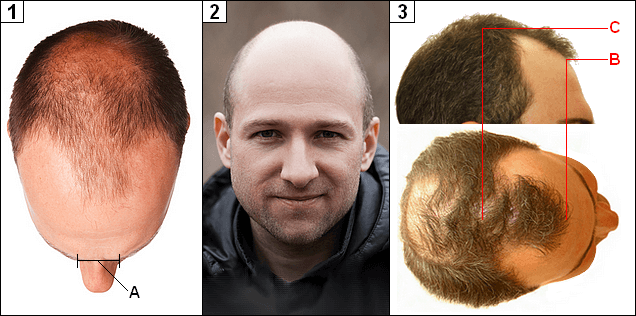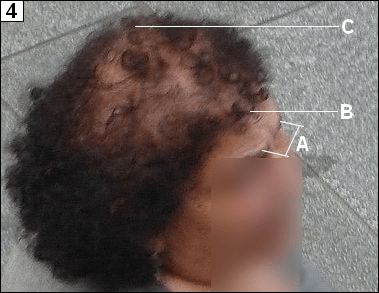- Home
- Skull Expansion
- Receding Hairlines
The Real Reason for Receding Hairlines
By Paul Taylor
Whether or not you develop a receding hairline (receding temples) all depends on the shape of your skull.
That might sound hard to believe, but it’s true.
This page explains the real reason why the hairline recedes, and why receding temples affect so many men but are much less likely in women.

Important Skull Shape Characteristics
Hair loss at the front of the head is caused by skull expansion (skull bone growth) of the frontal bone.
The frontal bone extends from the top of each eye socket (orbit), through the forehead and temples, and up towards the crown of the head, as you can see from the photos below.

The main characteristics to look for that determine whether or not the temples recede are:
1. Forehead width - How flat and broad is the forehead?
2. Forehead height - How high is the hairline in relation to the maximum height of the crown?
Sometimes a third factor might also apply:
3. Forehead angle - How steep or shallow is the forehead as it reaches up towards the hairline?
Those Who Do NOT Develop Receding Hairlines
In those men and women who never suffer a receding hairline, a very flat, broad forehead is almost always present (see line A in the photos below). This often gives a distinctive "square" outline to the face as you can see.
In the photos on the right, you can see that the hairline is quite high up (line B) in relation to the maximum height of the skull (line C).
This creates a sharp change in angle at the top of the skull where the forehead meets the crown, giving a somewhat flat crown and more square shape to the head when viewed side-on.
And this square shape can become even more apparent if the forehead is very steep (i.e., near vertical) as it reaches up to meet the hairline, as you can see.
This combination of a very flat, broad, tall and steep forehead is typical in those men and women who are highly unlikely to develop a receding hairline throughout life.
Those Who DO Develop Receding Hairlines
Now take a quick look at the photos below.

In photo 1, notice the curvature in the forehead? See how round it looks? This man has suffered severe hair loss from receding temples as a direct result of that curvature developing in the frontal bone during the skull expansion process.
You can also see a very distinct lack of symmetry in head width from front to back. The front is a lot narrower than it is at the back. And this "asymmetry" produces a much smaller flat area (line A) when compared to the equivalent photos in the last section.
And it often gives a very "rounded" head shape when viewed face-on, as you can see in photo 2.
In photo 3, notice how the hairline appears quite low (line B) in relation to the maximum height of the skull (line C) when compared to the equivalent photos in the last section.
There is also increased curvature to the skull as it rises up to its maximum height, creating a somewhat rounded shape to the head when viewed side-on.
From the many years of observation and research I have done, I believe any man with these skull shape characteristics is highly likely to develop receding temples and, quite possibly, severe hair loss up to the top of the crown as well (frontal baldness).
And these skull shape characteristics can also apply to women.
In photo 4 below, you can see that this lady similarly does not appear to have a flat, broad forehead (line A) and her hairline (line B) also seems much lower in relation to the maximum height of her skull (line C).

However, it is very rare for women to develop receding temples, as explained in the next section.
Why Women Don't Get Receding Temples
Most women are much less likely than men to develop receding temples at the front, or bald spots and patches at the back of the head.
Instead, they usually tend to experience hair thinning (diffuse hair loss) across the same crown and frontal region of the scalp as men (1), as you can see from photo 4 above.
There are two main reasons why women don't suffer this type of hair loss (androgenetic alopecia) as much as men:
1. Skull shape and size.
2. Lower levels of testosterone and DHT.
1. Skull shape and size
Skull shape and size are sexually dimorphic characteristics, which means they can often vary between men and women.
Other, more obvious examples of
sexual dimorphism include wider hips in women, and more height and
weight in men (due to bigger bones and greater muscle development) (2).
Sexual dimorphism is largely determined by genetics and androgens (steroid hormones) such as dihydrotestosterone (DHT) (2). In other words, the exact same two things that have also been linked to androgenetic alopecia.
And that's no coincidence. As you’ve just read, skull expansion of the frontal bone causes this type of hair loss. And whether or not skull expansion takes place, all depends on the shape of the skull.
Most men tend to have skull shapes
with, what I call, a "high growth potential". In other words, they’re
more prone towards skull expansion (and hair loss). However, most women will
generally maintain a smaller, more "juvenile" skull shape throughout
life (see photo below).

However, some women do suffer quite severe frontal hair loss, as you can see from the photo below.
This
lady does at least seem to have a quite a flat, broad forehead. But
her frontal bone has still grown, producing the area of baldness you can
see just behind her hairline. She also looks quite elderly, and this is
an important factor as you’ll see in the next section.

2. Lower levels of testosterone and DHT
Both testosterone and DHT are steroid hormones, which means they have an anabolic effect on the body (2). These two hormones can stimulate the growth of bone (3), muscle (4) and hair.
Which is why during puberty, when levels of these hormones are much higher in men than they are in women, men start growing facial and body hair (5), and also experience greater muscle and bone growth.
And this bone growth can also include the skull. Some men start developing skull expansion and hair loss from puberty onwards (6). And it’s a combination of high DHT levels and skull shape that drives this process.
But, for most women, the differences they have with men in skull shape, along with much lower DHT levels (7), mean they are highly unlikely to develop skull expansion and hair loss at such a young age.
And this should remain the case as long as their DHT levels remain low and their estrogen levels stay high.
Usually, it’s only after the
menopause when estrogen levels drop, that DHT will start to assert
itself on the female body. This will often cause facial hair growth (8), but
can also start the skull expansion and hair loss process in those women
with the skull shape characteristics described above.

However, without these skull shape characteristics, the frontal bone in women should stay proportionately smaller than it is in the majority of men.
Which means that, whilst many women still suffer this type of hair loss, they are far more likely to develop thinning hair rather than receding hairlines and frontal baldness as in most men.
This is page 4 of 6.
Read next page? Extreme skull expansion – extreme hair loss!
Read previous page? Why the "pattern" in male pattern baldness develops.
Note: Only a very simplified look at the skull shape characteristics that cause receding hairlines has been given on this page. Other factors can also be involved.
|
Like this page? |
|


